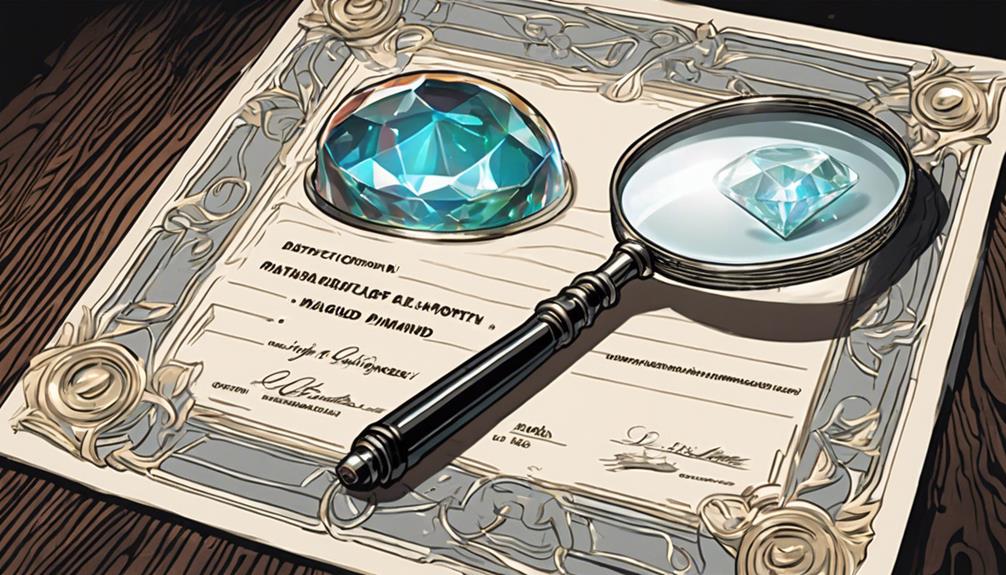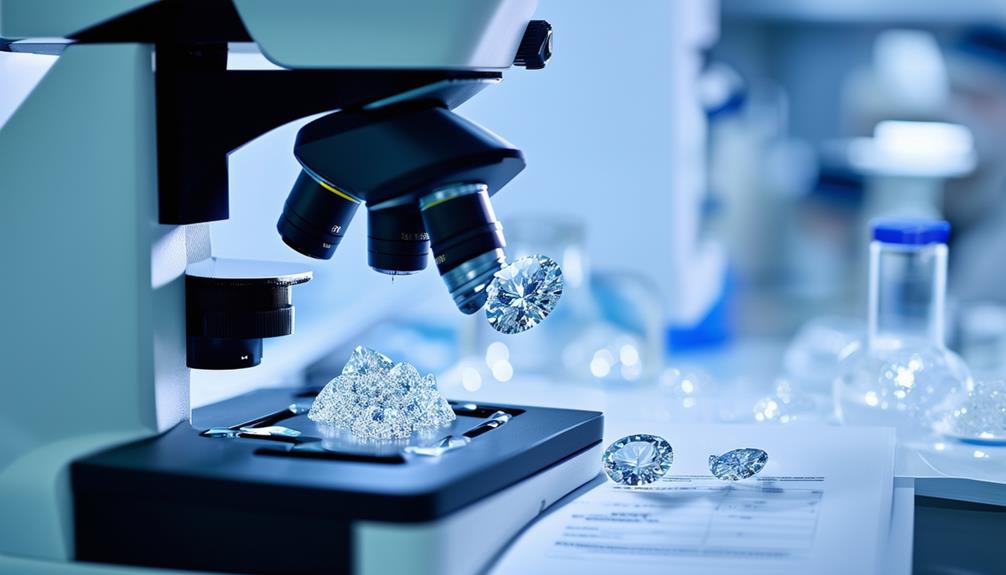Article Contents
The quality of lab-grown diamonds is assessed primarily through the 4Cs: Carat, Cut, Colour, and Clarity. The Cut enhances the diamond's ability to reflect light, increasing its brilliance and scintillation.
Colour is evaluated using scales like the GIA's D-to-Z range, which measures the absence of colour in diamonds, influencing their overall appeal.
Clarity refers to the presence of inclusions, affecting both the diamond's appearance and durability.
Certifications from trusted organisations such as the GIA or IGI confirm these quality attributes, ensuring that each diamond adheres to high standards of beauty and craftsmanship. These aspects are critical in understanding the properties and value of lab-grown diamonds.
Key Points
- The quality of lab-grown diamonds is primarily determined by factors such as carat weight, cut quality, colour grade, and clarity grade.
- A precise cut enhances the diamond's ability to interact with light, significantly increasing its brilliance and visual appeal.
- The colour of a diamond, rated on a scale from D (colourless) to Z (light yellow or brown), plays a crucial role in determining its luminosity and market value.
- Clarity refers to the presence of inclusions and blemishes in a diamond, which can impact its brilliance and overall value.
- Certifications from respected organisations confirm the authenticity of the diamond and ensure that it meets established quality standards.
Understanding the 4Cs
To evaluate the quality of lab-grown diamonds effectively, it's crucial to comprehend the 4Cs: carat weight, cut quality, colour grade, and clarity grade. These factors collectively determine a diamond's appeal and value, empowering consumers to make choices that align with their preferences for beauty and ethics.
The cut quality is especially vital as it directly affects a diamond's brilliance and light performance. A skilfully cut diamond optimises the reflection and refraction of light, enhancing its sparkle and producing the captivating fire that is highly prized. This quality is essential because it dictates how light interacts with the diamond, fundamentally impacting its visual appeal.
Colour variation, which is assessed under colour grading, also plays a critical role. Even minor differences in hue can alter the diamond's overall look. The precision in cutting influences how light is directed within the diamond, affecting both its colour perception and its luminosity. Such meticulous consideration of optical physics allows lab-grown diamonds to emulate the visual allure of natural diamonds, offering consumers high-quality alternatives without ethical or aesthetic compromise.
Colour Grading Standards
In understanding the quality of lab-grown diamonds, it's crucial to consider the role of colour grading standards. The Gemological Institute of America (GIA) employs a grading system ranging from D (colourless) to Z (noticeable colour) for colourless diamonds. This scale is instrumental in determining their market value, with the most colourless stones typically being the most desirable. The processes used in the growth and treatment of these diamonds can significantly impact their colour and, consequently, their grade.
For fancy coloured lab-grown diamonds, the grading is more complex and focuses on hue, tone, and saturation. These elements are crucial indicators of the advanced technologies and chemical processes used in the diamonds' creation, allowing for precise colour manipulation. This capability enables producers to meet varied market demands by offering a wide range of unique colours, enhancing consumer choice and expression.
A deep understanding of these grading standards is essential not only for appreciating the aesthetic qualities of diamonds but also for valuing the scientific advancements they represent. Such knowledge ensures that consumers can make informed choices, selecting diamonds that align with their quality expectations and ethical considerations.
Clarity and Inclusion Types
When discussing clarity and inclusion types in lab-grown diamonds, the Clarity Grading Scale is crucial. It categorises diamonds from Internally Flawless to Included 2.
This grading scale is pivotal for identifying typical inclusions such as graining, feathers, cavities, and beardings. These inclusions affect the diamond's brilliance and aesthetic value.
The degree of visibility of these imperfections plays a critical role in determining the diamond's light performance and market value. Understanding this scale provides a standardised method to assess and compare the quality of lab-grown diamonds reliably.
Clarity Grading Scale
The clarity grading scale for lab-grown diamonds, ranging from Internally Flawless to Included 2, is crucial for assessing imperfections visible under 10x magnification. This scale provides essential information, helping consumers make well-informed choices by understanding the quality and attributes of each diamond.
As gemmological technology evolves, clarity enhancement methods are refined to meet current consumer demands and market conditions, ensuring the distinctiveness of each stone is accentuated and the lab-grown diamond industry remains transparent.
Common Inclusion Forms
Lab-grown diamonds often contain inclusions like graining, feathers, cavities, and beardings, which are crucial for determining their clarity grades. These imperfections are carefully assessed during the inclusion identification and grading processes, considering their size, nature, number, location, and visibility under 10x magnification.
This detailed evaluation helps to customise clarity enhancement techniques for each diamond, enhancing its appearance while maintaining its structural integrity. For example, diamonds with VS1 and VS2 clarity grades show few imperfections, whereas those in the SI1 and SI2 categories appear mostly flawless to the naked eye, showcasing a perfect blend of innate characteristics and expert craftsmanship.
Impact on Brilliance
Exploring how inclusions affect the clarity of lab-grown diamonds reveals their overall brilliance and attractiveness. Clarity is crucial in these synthetic diamonds because inclusions can significantly impact how light is reflected and dispersed, directly affecting the diamond's sparkle.
The synthesis method, either High Pressure High Temperature (HPHT) or Chemical Vapor Deposition (CVD), influences the type and visibility of inclusions, which in turn affects the diamond's light performance and visual appeal. Diamonds with higher clarity grades, such as VS, have fewer visible inclusions, ensuring superior light performance and maximum brilliance.
Therefore, understanding the nature and location of inclusions is vital for assessing a diamond's brilliance and aesthetic value.
Impact of Cut on Brilliance

The precision in the cut of lab-grown diamonds significantly enhances their brilliance by optimising light reflection.
Symmetrically aligned facets are crucial for maximising scintillation and fire, thereby boosting both the visual appeal and market value of these stones.
This meticulous focus on cut quality is essential for their performance and desirability.
Trim Proportions Improve Reflections
Ideal cut proportions in lab-grown diamonds significantly enhance their brilliance by optimising light reflection and internal refraction. These precision cuts are crucial for maximising light performance, which directly enhances the diamond's visual appeal and overall beauty. Popular cut styles such as the round brilliant and cushion cut are specifically designed to optimise the diamond's potential for brightness, fire, and scintillation.
| Cut Style | Light Interaction | Visual Impact |
|---|---|---|
| Round Brilliant | Maximises Reflection | Exceptional Brilliance |
| Princess | Intensifies Fire | Contemporary Brilliance |
| Cushion | Boosts Scintillation | Softened Elegance |
Each cut style provides a distinct aesthetic, enabling individuals to select a diamond that aligns with their personal preferences and values.
Facet Symmetry and Light
Facet symmetry significantly enhances the visual appeal and light performance of lab-grown diamonds. Accurate facet alignment boosts the diamond's sparkle, crucial for maximising its brilliance.
Symmetrical facets ensure optimal light dispersion, vital for showcasing the diamond's fire, scintillation, and brightness. Such precision in the cut not only makes the diamond more captivating but also increases its value and appeal.
Therefore, cut quality is a critical aspect in assessing the overall excellence and attractiveness of the gem.
Carat Weight Considerations
Carat weight plays a crucial role in assessing lab-grown diamonds, directly influencing both their visual appeal and market value. As the carat weight increases, the price escalates due to the higher volume of material required and the lengthier production process. Thus, the carat weight is a vital metric for determining a diamond's market value.
Aesthetically, a higher carat weight enhances a diamond's visual prominence, making it a focal point in jewellery designs. However, smaller carats, while less imposing, provide flexibility and subtlety, appealing to different tastes and preferences. Selecting the appropriate carat weight necessitates balancing personal style and budgetary limits. It involves choosing a diamond that aligns with your financial capabilities and aesthetic preferences, ensuring it complements the intended style and statement of the jewellery.
Therefore, carat weight is not merely a size indicator but a key factor that shapes the overall impact and perception of lab-grown diamonds.
Certification and Authentication

Certification of lab-grown diamonds is essential to confirm their authenticity, quality, and ethical production. Independent labs such as the Gemological Institute of America (GIA), American Gem Society (AGS), International Gemological Institute (IGI), HRD Antwerp, and Gem Certification & Assurance Lab (GCAL) provide reputable certifications. These organisations evaluate each diamond thoroughly, offering reports that detail the 4Cs—carat, cut, colour, clarity—and verify its lab-grown status.
These certifications ensure transparency and allow consumers to make informed decisions, emphasising ethical sourcing and responsible consumerism. This transparency is crucial for those who value informed purchasing choices, enhancing consumer understanding and enabling better navigation through the lab-grown diamond market.
Frequently Asked Questions
Are there different qualities in lab-grown diamonds?
Yes, lab-grown diamonds vary in quality depending on the production methods used, such as High Pressure High Temperature (HPHT) and Chemical Vapor Deposition (CVD). These methods affect factors like the diamond's colour and clarity. Consumers can select diamonds that match their preferences and values by taking into account these production variances.
How can you tell if a lab-grown diamond is of good quality?
To assess the quality of a lab-grown diamond, pay attention to its cut to ensure maximum sparkle, and check its certificates from respected institutions that evaluate colour, clarity, and workmanship.
What Is the Best Grade of Lab-Grown Diamonds?
The highest quality lab-grown diamonds are designated with a D colour grade and Internally Flawless clarity. These diamonds excel due to their precision cutting and reliable certification, appealing to those seeking the best options available.
How to Choose the Best Lab Grown Diamond?
To choose the best lab-grown diamond, begin by comparing prices and ensuring the sourcing is ethical. Pay attention to the diamond's cut, colour, and clarity to make sure these attributes align with your personal preferences and standards. This method will assist you in making a well-informed and ethically conscious decision.
Summary
The quality of lab-grown diamonds is assessed using the 4Cs framework: colour, clarity, cut, and carat weight. According to the Gemological Institute of America, around 70% of lab-grown diamonds are given a colour grade in the D to F range, emphasising their resemblance to high-quality natural diamonds.
Certifications are essential as they verify that these quality characteristics meet rigorous standards, guaranteeing the diamonds' authenticity prior to being purchased by customers.

